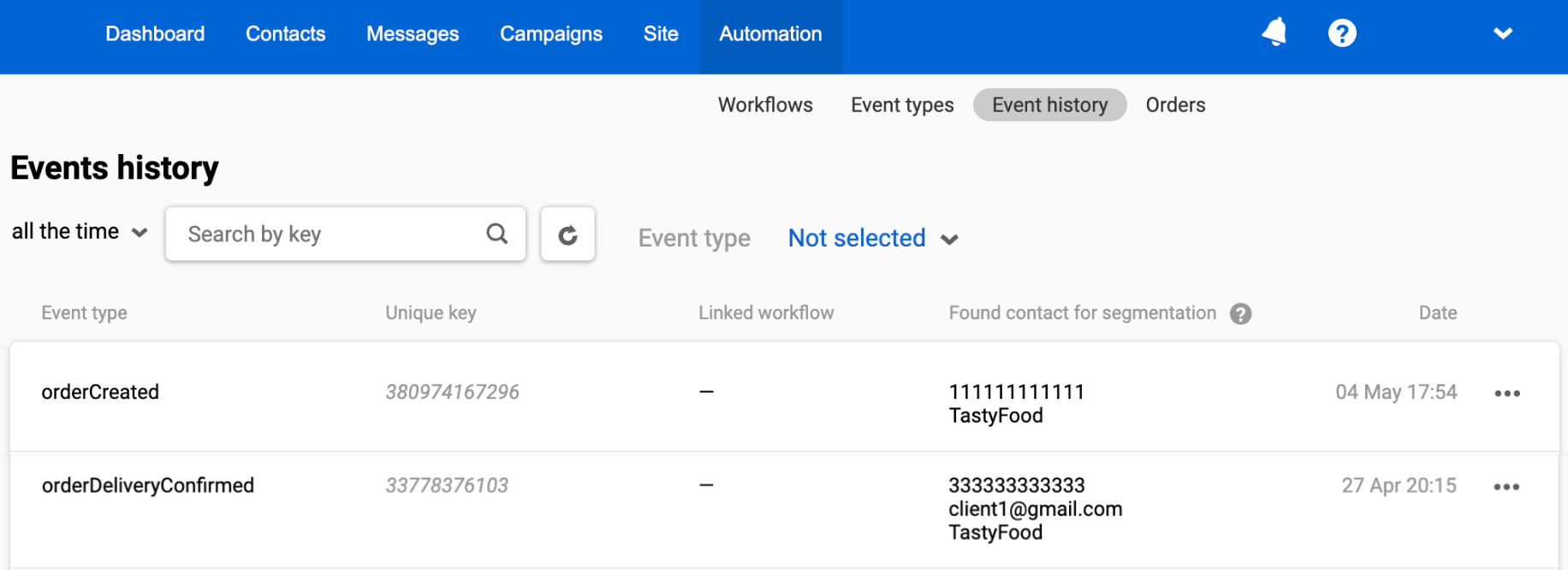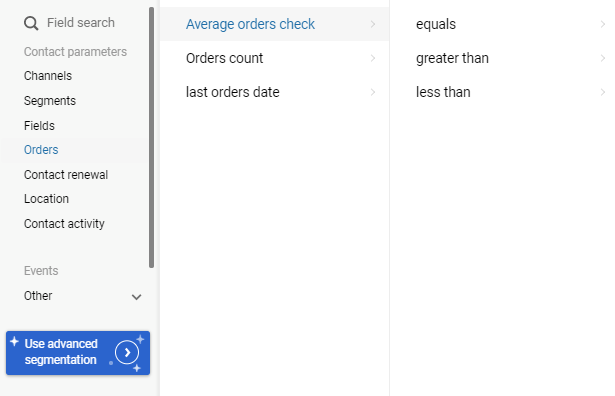Order Transfer Using the Add Orders API Method
To transfer orders, send a request using the Add orders API method. You can transfer up to 1000 orders in one request.
Every time you send an API order, the system creates an event that can trigger a workflow. You can create different events for different order statuses, which allows setting triggers for each change in the order status.
Event Names
Event names consist of two parts: the word order and its status, for example, orderINITIALIZED, orderIN_PROGRESS, orderDELIVERED, orderCANCELLED, orderABANDONED_SHOPPING_CART.
To see the created events, go to Automation → Event history.

Event Parameters
Each event contains required parameters and can include optional parameters.
${eventKey}- event unique key transferred inexternalOrderId. Used as an order identifier;${orderId}- event ID in our system. Required to assign the event to a workflow.
The contact ID must be one of the following:
${externalCustomerId}- external contact ID;${email}- contact’s email address;${phone}- contact’s phone number if it’s transferred in the event.
ImportantIf there is no external customer ID, email or phone number in the event, the system can't match the contact with the order and can’t send messages to such contacts. In such cases, you can see contact ID in the Automation → Orders tab → Contact data column
To substitute parameter values in messages, send the fields with event parameters as an array.
- Required parameters for the
ordersarray: externalOrderId, totalCost, status, date, currency. - Required parameters for the
itemsarray: externalItemId, quantity.
NoteThe price of the products transferred in an order must match the totalCost value (total order amount). If a customer buys an item with a discount, it should be placed in the items.cost field for each product.
You don't need to transfer the items array if you don't use product data in messages or send orders only for RFM analysis.
Format of date: YYYY-MM-DD; format of date with the time: YYYY-MM-DDTHH:mm±hh:mm.
Important
- The date event parameter must be passed in the
ISO 8601format with a specified time zone offset relative to UTC. For example:2025-01-05T13:00:00+02:00, where +02:00 indicates that the local time is 2 hours ahead of UTC.- Note that some countries observe daylight saving time (DST), which may affect the offset.
See the full list of order fields with descriptions >.
Request body example:
{
"orders": [
{
"externalOrderId": "100500",
"externalCustomerId": "12345",
"totalCost": 1000,
"status": "INITIALIZED",
"date": "2017-03-08T09:30:00+02:00",
"email": "[email protected]",
"phone": "380942583691",
"firstName": "John",
"lastName": "Smith",
"currency": "USD",
"shipping": 10,
"discount": 0,
"deliveryMethod": "express",
"paymentMethod": "cash",
"deliveryAddress": "First str. 1",
"items": [
{
"externalItemId": "200600",
"name": "Super Device",
"category": "devices",
"quantity": 1,
"cost": 990,
"url": "http://example.com/item/200600",
"imageUrl": "http://example.com/item/200600/image.png",
"description": "High quality"
}
]
}
]
}If the request is successful, the server returns the 200 status code. The response body contains the list of orders that cannot be added or updated.
The possible reasons for an order to fail:
- One or more required fields are empty, or the format is incorrect.
- All the following optional fields are empty: externalCustomerId, email, phone. At least one of them is required for order creation.
ImportantOnly orders with the
DELIVEREDstatus are used to build the RFM table and calculate revenue from campaigns on the Report tab.Exceptions are orders received from the mobile SDK, in which case the statuses
INITIALIZEDandDELIVEREDare taken into account by default in the revenue visualization. If necessary, theINITIALIZEDstatuses can be disabled — for this, contact our support service [email protected]
You can use orders with the DELIVERED status to build segments with the following conditions: average check, order count, last order date.

Send an ABANDONED_SHOPPING_CART status for abandoned carts. Use it if you track abandoned carts on an external platform. If you use web tracking, you don’t need to send abandoned cart events through API.
To update the status or other order data, send an updated order with the same externalOrderId parameter. It determines the order's uniqueness in the system.
Checking Event Parameters
To check whether the order is sent to the system with all the parameters, go to Automation → Orders. Click the order ID to see all the fields in JSON format. Also, you can see information about the contact by clicking Contact preview icon.
ImportantFor each unique contact, transfer a unique
externalCustomerIdparameter with the phone number or email that should be the same in the order and the contact card.
- If you’ve already sent the order with this
externalCustomerIdvalue, the system will automatically assign a new order to the contact with this ID.- If the
externalCustomerIdvalue is new, the system will match it by phone number or email.
Creating Workflows
- Go to Automation → Workflows and click New workflow.

- Specify the workflow name (e.g., Order delivered, Order in progress, etc.)
- Add the following blocks to the workflow:
- The Task block → the Get order task name. The block will pull out all the order data and send it to the email.
- A message-sending block. Select the message that you previously created for this workflow (order notification, NPS, etc.)

Instead of one message, you can make a series. For example, 1-2 weeks after notification of the delivered order, send a request to leave a review.
Learn more about setting workflow start and stop conditions >
Updated 5 months ago